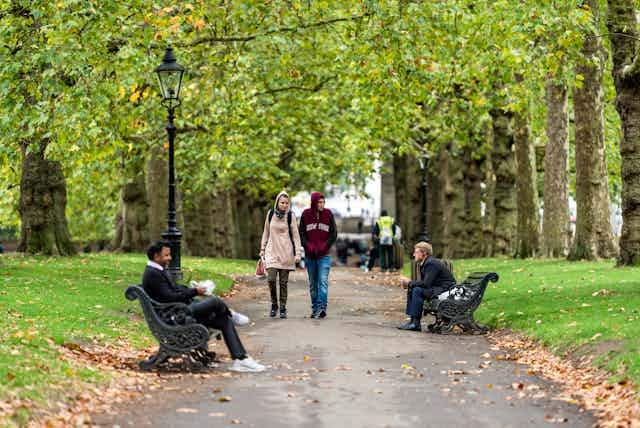Green spaces in city neighbourhoods are critical for wellbeing. A huge amount of research proves their positive health benefits: they support mental and physical health, reduce stress, and cut noise and air pollution.
Policymakers know this, which is why they put local authorities under pressure to keep parks and green spaces open during lockdown.
However, there is a large gap between what this research shows should be done to maximise the benefits of urban green space, and what is actually put in place in cities. Politicians are keen to talk up the benefits of parks and other outdoor spaces – but less eager to spend money on their upkeep.
Our new research demonstrates the gap between what decision-makers say and what happens in practice, and shows that it could worsen access to urban green spaces in the future.
Policy promises
Sometimes policy aspirations can never actually be achieved in practice. Take planting trees as an example. The UK government states it will plant 11 million trees in England by 2022, including one million urban trees.
However, 30-50% of those urban trees may fail in their first year. Perhaps only half will survive because they are often planted in the wrong place, in compacted soil or are simply not watered or looked after properly. There is a huge difference between planting trees and establishing them.

Local decision-makers often set big targets for parks and green space in strategy documents. These strategies are carefully worded documents which are aspirational and full of aims, objectives and actions.
In Nottingham, for instance, the city council’s strategy for green space targets “more people using open and green spaces, more often”, while in Southampton the city council’s aim is “to provide a network of high-quality green spaces contributing to a unique sense of place”. However, these strategy documents do not always have a legal force so it is difficult to hold policymakers to account.
It can be almost impossible to assess whether strategic goals have been achieved. We looked at two consecutive green space strategy documents produced by the London borough the City of Westminster, to see if their targets set in the first – published in 2007 – had been met by the time the second strategy document was issued in 2019.

We thought this would be relatively simple to find out, but it soon became clear it was an impossible mission and we hit a number of stumbling blocks. In part this was because, over time, different datasets were used, meaning that direct before and after comparisons could not be made.
Some datasets held by Westminster council referred to “green space” but others considered “open space”. This might seem like a minor difference, but the first strategy set out to increase the amount of green space. This all meant that we simply could not find out from the later strategy with certainty whether this had actually happened.
Targets that will never be achieved
Setting a target of increasing the amount of urban green space is eye-catching and appealing. It is particularly attractive in high-density cities, where not all urban residents have access to a garden and so rely on having a park or green space within walking distance.
There are creative ways to categorise green space. Roof gardens and green walls are increasingly included in definitions of green space, as are AstroTurf football pitches. But if city dwellers can’t access a green wall or get to the roof garden on top of a building because it is locked to non-residents, should they count? Some local authorities describe synthetic football pitches as “publicly accessible open space”, but they may be locked facilities that users must book and pay to use.

Without statutory funding for parks and green spaces, it’s perhaps little wonder that green space strategies exude hope through lofty aspirations but cannot detail their achievements. When councils are put under pressure to find cost savings, parks’ budgets are often targeted. For example, Newcastle City Council’s parks budget was reduced by 90% between 2010-17.
COVID-19 has shown us how much we rely on urban green spaces for our mental and physical health. The government is currently carrying out a comprehensive spending review, which assesses budgets for different government departments. It provides a timely opportunity to get urban green spaces back on the political radar.
It would be a backward step to continue the current approach to urban parks, where green space strategies are largely aspirational. Parks require the ongoing funding that reflects the essential service they provide.

